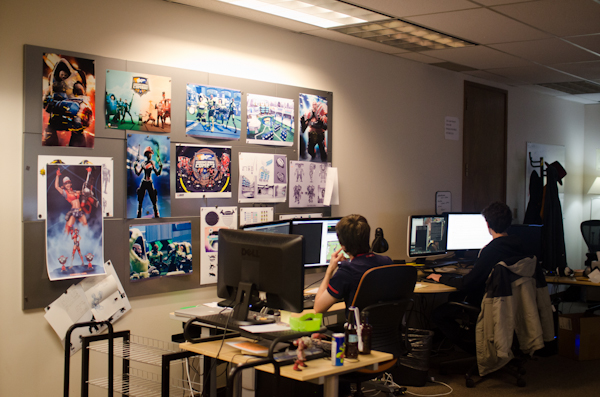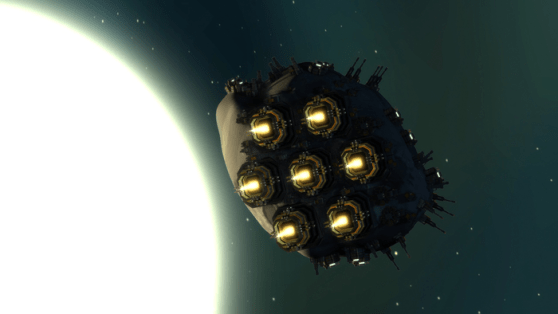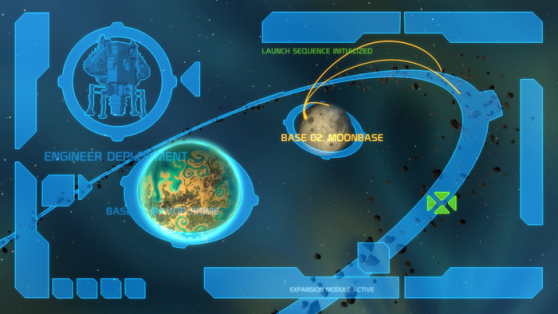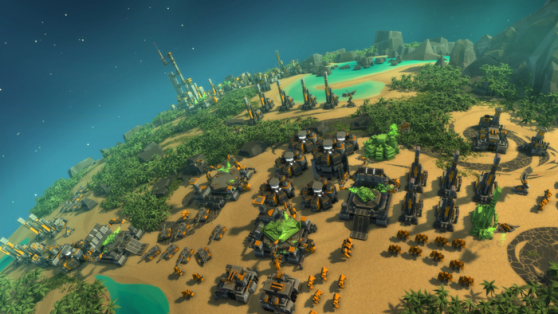 A day before the Penny Arcade Expo, I went to Uber Entertainment’s studios in Kirkland, Wash. to talk to Jon Mavor, the studio’s chief technology officer and creative director for Planetary Annihilation, an upcoming real-time strategy (RTS) game that has reached it’s Kickstarter funding goal and — with just a few days left for funding — is close to doubling it. I spoke at length (you’ll be able to read the full transcript of the interview shortly) with Mavor about everything that Uber is doing. But most importantly, we discussed Planetary Annihilation, a spiritual successor to the acclaimed Total Annihilation that Mavor and a number of current Uber employees originally worked on.
A day before the Penny Arcade Expo, I went to Uber Entertainment’s studios in Kirkland, Wash. to talk to Jon Mavor, the studio’s chief technology officer and creative director for Planetary Annihilation, an upcoming real-time strategy (RTS) game that has reached it’s Kickstarter funding goal and — with just a few days left for funding — is close to doubling it. I spoke at length (you’ll be able to read the full transcript of the interview shortly) with Mavor about everything that Uber is doing. But most importantly, we discussed Planetary Annihilation, a spiritual successor to the acclaimed Total Annihilation that Mavor and a number of current Uber employees originally worked on.
(Transcription courtesy of TranscribeMe!)
Planetary Annihilation has been in concept for about three years
While Total Annihilation released back in 1997, Mavor has been playing with the concept of an interplanetary RTS for a few years. Sure, he worked on 2007’s Supreme Commander, but Mavor has toyed with ideas like hurling asteroids at planets since the development of Super Monday Night Combat. “Visualization started about three months ago,” Mavor told VentureBeat in an exclusive interview. “We’ve been working on the engine tech and thinking about the game for literally a couple of years. I’ve had the idea rolling around in my head for [at least] that long.” The technology behind the game has been in production for several years now, though, specifically on the server end thanks to UberNet.
UberNet is Uber Entertainment’s back-end server network, which the developer has been creating and refining for both its own games and third-party titles. With UberNet, Planetary Annihilation will be completely server-based.
Planetary Annihilation lets you run your own servers

Above: Jon Mavor, the creative director on Planetary Annihilation
Mavor is adamant about making Planetary Annihilation as friendly to players as possible. Matches are persistent — one competitor can leave and not disrupt everyone else — and playable via Uber’s official servers, or users can meet up on their own servers. Through UberNet, players can access a matchmaking service where they can challenge anyone around the world, or they could choose to just start a quirky game with friends.
“This is something … that the community asked for. You can play on [Windows, Linux, and Mac]. You can set up a Linux server and then play on your PC if you want or any combination thereof. They said, ‘We want DRM-free [digital-rights management], and we want to be able to run LAN servers,'” said Mavor. And while UberNet doesn’t currently support clans or tournaments (something that the company is actively working on) users can create their own. “The difference between our official servers and end-user servers is how we set them up. [For] end-user servers, you’ll see individuals who just want to run their own games with friends, you’ll see clans, you’ll see mod servers and different kinds of gameplay,” said Mavor.
Even if you don’t have access to your own personal server, you can still play private matches on Uber’s hardware; although, you will be restricted to Uber’s rules and current game limitations.
Why Planetary Annihilation won’t receive a standard single-player campaign
While my interview with Mavor took place before the fourth stretch goal, when the developer revealed a computer-generated single-player campaign called the “Galactic War,” Mavor was very clear that Planetary Annihilation won’t feature a traditional campaign. “The emphasis [of Planetary Annihilation] is on having a good skirmish mode for the single-player. We’ve seen that a lot of people play through the campaign once or twice and then never play it for a decade. But skirmish they play all the time.”
My own experience with Total Annihilation mirrors Mavor’s sentiment, but the beauty of having a campaign is not only to share a story (a narrative background for the game), but also to teach players how to play at a professionally set pace. Mavor thinks that’s unnecessary. “Our approach on Total Annihilation was the model — kind of like the Command and Conquer model. The game hadn’t been made before. We really didn’t have any notion of what we could change and get rid of, and nowadays, we do. There’s a built-in community already that’s going to teach you bottom play. There [are] built-in community players already.” With so many fans of games like Total Annihilation or Supreme Commander, the install base for Planetary Annihilation is already set. The people putting money in the Kickstarter, according to Mavor, are the people who already know how to play or will know how to learn from the community.
Minimum specifications: currently Sandy Bridge for 2-4 players
Planetary Annihilation is being built to run on everyday computers. The minimum specs? “Anything past Sandy Bridge as far as embedded graphics go,” Mavor stated, going further to discuss how computer hardware is stabilizing around major platforms like Intel’s latest chipsets. “[Sandy Bridge is] what I’m aiming for, but we haven’t announced final specs. To some extent, it’s too early to say because maybe we will get halfway through the game and go, ‘You know what, if we just amp the specs up a little bit …’ we’re going to have a much better game. I don’t necessarily anticipate that.”
The minimum specifications for Planetary Annihilation aren’t set in stone, but last year’s Intel processors aren’t exactly a high standard for gaming. Nearly all laptops and ultrabooks made within the past year and a half use the Sandy Bridge platform or the newer Ivy Bridge processors from Intel. However, PA will support more than four players at a time, which will require more computing power. Playing on a more powerful machine will be critical.
Planetary Annihilation will support games of up to 40 players, spanning an entire solar system

“To me, that’s a whole unexplored area of gameplay that could be really cool … but we don’t know how it’s gonna work out.” Forty-player games, which Mavor spoke with PC Gamer about, is something that Uber is still actively investigating but is wholly interested in pursuing. “The 40-player game is to see what the community goes with …. I see it as being really extra super hardcore. Like, how many people want to play a game that lasts for 40 hours, or something like that?”
I was skeptical about such a massive game because as anyone who can’t sit in front of a computer to play a game for five hours at a time — let alone 40 — it doesn’t seem realistic. But because games are persistent and played through servers, players can jump in and out anytime to do things like go to work, maintain a relationship, eat, sleep, etc. And the game will continue. Players have the option to have AI take over when they leave, or the units simply carry on in the player’s absence in autopilot. Units will defend themselves when attacked and continue performing any tasks previously assigned, but they won’t play on their own.
But how would a game like that work? Mavor sees such a massive game more playable in teams — in a solar system with several planets with four or five players per world. As individuals get knocked out, the limited resources open up to the rest of the players until only a few factions remain and wage a full-scale planetary war. “But how the hell all that’s going to work out is totally speculative. I think it’s going to be really cool, but it’s never been done before.”
An interesting sidenote regarding 40-player matches: While the game is still in very early stages of development, Uber hasn’t actually played a 40-player game yet. This shouldn’t come as a surprise; the game isn’t even close to release, something Mavor is eager to remind Kickstarter funders.
“We’re not going for realism. We’re going for awesome.“

Above: Uber Entertainment’s office in Kirkland, Wash.
With so many potentially massive things available in Planetary Annihilation, I had to settle exactly what the level of realism is. Will destroying a moon change ocean currents to potentially dangerous levels? Will players be able to move entire planets and use them as weapons? Can celestial bodies be hurled into a nearby sun, or can orbits be altered to produce the same effect? Because, as Uber Entertainment’s creative director John Comes so succinctly put it, “We’re not going for realism. We’re going for awesome.”
What exactly does that mean?
Gas giants will support orbital and air units only
Originally, Uber made it clear that gas giants would have some special form of land but, for the most part, would require using only orbital and air units. But the fans weren’t having any of that. “I’m starting to go back on [ground for gas giants] because everyone’s like, ‘No, we don’t want any land,'” Mavor conceded. “Fine, that’s less work. We won’t put any land on it.”
The original idea for physical terrain on gas giants was tiny areas where commanders could build small bases, utilizing special surfaces, but because of the community outcry, the decision was made. “If you don’t want any land, we won’t put any land.”
What does that mean for how games on gas giants will work? Orbital units will play an extremely important role for resource collection, and energy can be extracted through orbital gas mines. As for the commaner’s role, that’s still undecided.
The scale of realism: planets as weapons

One of the coolest features in PA is how asteroids can be used as weapons by building engines on them and literally hurling them at planets. This raised a number of questions: What is the scale for moving heavenly bodies? Do all asteroids destroy planets upon collision? How realistic will the game be? Where is that balance?
For starters, the split for PA is in three groups: realism, awesome, and fantastical. For the moment, all game features fluctuate between the former two, so ideas like putting engines on a gas giant are out of the question. One funny theoretical question Mavor heard from the forums was landing — meaning not crashing — an asteroid on a planet to mine for additional resources and act as a barricade. In theory, it’s possible; in practice, “good luck.”
But how about moving planets altogether? Even if you cover the entire side of the planet with engines, “The simple answer is, there is no simple answer. Small planets … there’s a possibility. Big planets … I don’t think you’re going to be moving them.” That is to say, players can put as many engines as they want on a planet, but if the math doesn’t add up, it won’t have any effect.
“You can put engines on whatever you want […] but if there’s no delta-v, then there’s not enough to move the thing.”
Shooting stars and real stars
What about the sun? Can units or asteroids be tossed into the biggest furnace in the solar system? “No, they’re just background” — only there for visual effect.
Asteroids, however, have a pleasant medium that players can reach. With skirmishes planned on single-planet systems, it doesn’t make sense to just destroy the 99 percent of land mass in the solar system when most of your units are on it. “I’m trying to design the engine in such a way that it’s as flexible as I can possibly make it. You could theoretically have something blow up half the planet, and then the other half is still playable. I have ideas on how this is gonna work, but I don’t want to promise too much exactly because some of them are theoretical. But that’s the direction that I’m pushing for: that they eat away at these planets.”
Interplanetary Weapons

From the initial Kickstarter video, we were introduced to the concept of firing units from asteroids or other planets. In both Total Annihilation and Supreme Commander, there were major attack units that could fire across entire maps. That’ll be available in PA, too.
“There’s no reason why we can’t have big guns that shoot between planets or missiles that go between planets,” Mavor said. “There are going to be weapons that have interplanetary range. It’ll be limited, though. They won’t go halfway across the solar system.” So it is reasonable to expect weapons like the acclaimed Big Bertha or nuclear missile silos shooting between planets or even in minor orbital bombardments from orbiting asteroids.
That is to say, players can put weapons on an asteroid and have it orbit a planet, dropping heavy fire and combat units directly onto enemy bases. “You can cruise around a planet, fire off all your missiles, and then you’re [safe]. There are different strategic options here. So in some ways this space combat is like moving actual elements of the system around. These asteroids are your spaceships, in a way.”
But Planetary Annihilation is not a space-combat game
Don’t be fooled into thinking that PA has any space combat. All combat is ground-based. This game is not meant to be like Homeworld. “A lot of people ask for space combat, and it’s not really part of the vision for this game. It would be a whole separate game. It’s something we can try and develop and do later on in releases and expansions, but the only things I’m promising are the technological things that I know I could do and gameplay that I know is fun. That’s really what PA is all about.”
That said, space travel is part of the game — to send units between worlds and asteroids. This is more like a taxi ride. “There are different ways to move between planets, but the emphasis is on the planet, not the stuff that’s happening in between. There aren’t going to be big space armadas. It would be things that are in transit. [The focus] is on ground-based combat and orbital combat.”
What about super weapons? What about the Krogoth?
Total Annihilation fans will all remember the Krogoth, the impossibly massive killing machine that was by far the most dangerous unit ever conceived in an RTS. Such units will be in the game, but they are still under development. “I don’t have a problem with tech 3 like a Krogoth or some cool big units like that. We’re just not going to have a whole set of tech 3 units.” Players should expect some uniquely powerful units like the Krogoth, but there won’t be a major disparity between the different tech levels for units or between different factions.
Create your own solar system with the Procedural Map Editor

Playing on professionally made maps is great, but Uber is going to give players the ability to make their own maps and rate the best ones through UberNet. The Procedural Map Editor is expected to be an immensely powerful tool that will allow players to determine how big is the system, how many planets, how many asteroids, etc. Then individual planets will have slider tools for how much water versus land, forests versus mountains, and other broad parameters. Once those basic parameters are set, the general solar system is built, and players can go in-depth, editing finer details like roads, mountain ranges, etc. All maps can be saved and uploaded to UberNet’s servers to be voted on.
Multiple windows for a complete mission control display
Supreme Commander and several other RTS games supported multiple windows, and so will PA. The difference with PA is the limit to how many windows a player has based on your computer’s horsepower and network speed. Multiple windows allow players to see sections of the game map. “You can do whatever you want,” said Mavor with a funny grin. “If you open 20 windows, it’s going to go really slow, right? That comes under the heading of scalability.
“We’re not guaranteeing that [multiple windows] work on the minimum specifications by any stretch. The more windows you open up, the more bandwidth you need and the faster computer you need.” That’s because every new window reveals another section of the in-game map, which spans across an entire solar system. “That’s part of the reason why we’re supporting multiple windows. The bigger these battles are, the harder it is to manage.”
Players will be able to use both multiple displays (no limit to how many) and multiple windows (again, no limit), but each new window will require both additional computing power and Internet bandwidth to view properly. With more than four players, having multiple windows open will drive the minimum requirements up from a simple Sandy Bridge ultrabook to a very serious gaming rig. As of this writing, Uber hasn’t conducted enough testing to determine what the minimum spec will be for more players and multiple windows.
PC only today, but a future for tablets?
Mavor and I discussed the RTS genre and consoles, much to our displeasure, and he has no interest in bringing the PA to consoles, simply stating, “I don’t see how it would work.” What about mobile? “Not smartphones — they’re too small, but tablets maybe. It’s a possibility. It’s not the focus. I don’t see any reason why it wouldn’t work. I can see it down the road …. I think it could be pretty cool, actually.”
It isn’t Total Annihilation, but not for a lack of trying
Total Annihilation is a brand that, unfortunately, disappeared. The simple reason is that Atari owns the franchise. GT Interactive, the original publisher of Total Annihilation, was bought by Infogames, which ultimately bought the Atari name and became Atari. Yet the newly minted Atari hasn’t attempted to sell the franchise, and Mavor has spoken to the company about ownership of the brand, but they never reached an agreement.
“A lot of people have tried to get the rights to [Total Annihilation] from Atari over the years, but nobody has succeeded. I think it’s because they want too much, but they have never given me a number.”
That means that for TA fans, the names of the units will change, but the general style of gameplay will not. “They didn’t [sue us] with Supreme Commander. We’re not trying to make a sequel; we’re not saying this is Total Annihilation 2.”
Why use Kickstarter and not go with a publisher?
“We wanted to make the game for the fans. We don’t make it for a publisher. We don’t sit down and say, ‘What’s the game that would make the most money?’ We say, ‘What’s the game that we can make that would be the most fun?’ And I see the game as fan service, and me being a fan, I’m one of the people getting the service.
“A publisher would muck it up. I guarantee it. I mean, maybe there’s a publisher that wouldn’t. I haven’t met them yet. Our concern is making a fun game; their concern is making money.”
Planetary Annihilation is in its final days of Kickstarter funding, which ends on Friday, Sept. 14 at 12:20 PST.
VentureBeat's mission is to be a digital town square for technical decision-makers to gain knowledge about transformative enterprise technology and transact. Learn More

